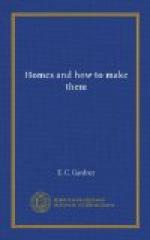In theory, the house being once warmed, the temperature within should scarcely change, even if the fire goes out. Practically, the walls cannot hold this subtile caloric, however scientifically they are padded. There will be crevices, too, though the prince of joiners builds your house, through which the warm air will escape. But replenishing this inevitable loss would be a small matter, if the breath of life were a needless luxury. Unless, however, we are willing to suck poison into our veins with every breath we draw, slow but sure,—poison expired from our lungs and emanating from our bodies, poisonous gases liberated by the combustion of fuel, poison dust and decay from the waste of inorganic material,—we must have a never-ceasing supply of fresh air around us everywhere and always. Now this incoming fluid, cold as ice, eats fuel like a hungry giant, yet we must receive it with open arms, and, as soon as fairly warmed, send it off through the ventilating flue, bearing whatever noxious elements may chance to be afloat, and, of course, much of the warmth we love and buy so dearly. We have then to supply these three sources of loss. Obviously for economy the two former must be prevented to the utmost, the latter rigidly controlled.
Thus far, except the old fogies who don’t believe in ventilation, we can all travel together harmoniously. Now our way divides, the doctors begin to differ, and the patients begin to die.
The first fork is at the two modes of warming, direct and indirect. The former includes stoves of all sorts,—sheet or cast iron, porcelain, soapstone, brick or pottery, box or cylinder, for wood or coal, air-tight, Franklin, “cannon,” or base-burner, parlor cook or kitchen cook, charcoal basin, warming-pan or foot-stove,—anything in which you can build a fire. It includes open grates and fireplaces, ancient or modern, large or small; it includes steam-pipes, hot-water pipes, and stove-pipes; and last, but not least, steam-radiators, than which it has never entered into the heart of man to conceive anything more surprising and unaccountable,—flat, pin-cushiony things, big as a bedquilt, dangerous-looking hedgehoggy affairs, some huge and bungling, others frail and leaky, but radiators still. In brief, the heating apparatus, whatever it may be, stands in the room to be warmed.
By the indirect mode it is enclosed in a chamber more or less remote, commonly called a furnace, and made of brick, sheet-iron, or wood lined with tin. Into this chamber cold air is admitted from some source, and escapes by its own levity, usually through tin pipes, to the rooms where the heat is needed. Sometimes it is driven out by mechanical means.
The advocates of the latter indirect mode claim for it many advantages. It is apparently clean. There are no ashes to be taken up, no hearths to sweep, no andirons to polish, no stoves to black. One fire will warm the entire house if well arranged, and, for a trump card, there may be a supply of fresh air straight from the north pole, but agreeably warmed, constantly entering the room.




